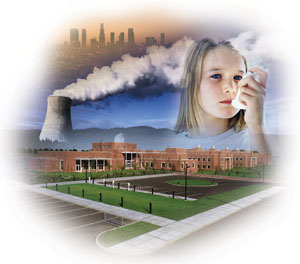I think most of us are familiar with the clever movie poster for An Invconvinient Truth, with the smoke from a factory swirling into a hurricane:

In fact, this same picture of a white plume coming from a factory or power plant stack is often used to illustrate articles on pollution. Just searching the first page of images googling "air pollution" gives us these relatively similar images illustrating air pollution articles:








Here is a big Roseanne Rosanadana Emily Litella moment for all of you using these images: The big white cloud coming out of all those stacks is steam. Water vapor. H2O. Though actually a much more powerful greenhouse gas than CO2, no one has had the temerity to label water a pollutant (except in that great Bullshit! issue when Penn & Teller get environmentalists to sign a petition banning dihydrogen monoxide). All of these guys are using big plumes of water vapor to panic people about pollution. That is because most pollutants emitted by combustion are invisible. Visible smoke was licked by most plants decades ago (here is the only "factory" picture in the google search I could find with actual smoke).
Just to avoid being misunderstood, my point is not that pollution is OK because it is invisible. My point is that these scare pictures are yet another example of how environmentalists feel its OK to ignore science to advance their agenda in public. Sometimes they even go further, as Small Dead Animals points out, resorting to photo-shopping to make things seem worse, but the dreaded steam plumes are still there front and center. (I noticed that several of the pictures above where photographed at sunset. I thought at first this was to make them look prettier, but maybe they liked the effect because it made the steam look browner without photo-shopping).
I did not go too deep into the Google search, but I went far enough to award my personal favorite for a scare picture that has nothing to do with the point being made:

This one is a classic, with the sad-faced little girl and her asthma** inhaler super-imposed over a scene of "industrial pollution." Except, the scene is from a nuclear power plant! The unique shaped cooling tower is almost exclusively used on nuclear power plants, but the ultimate proof is the small nuclear reactor containment dome you can see to the right. That plume, which is supposed to represent pollution, has to be 100% water. There are no combustion products at a nuclear plant, and even if there were, given the way the cooling tower works, this can only be water vapor coming out of the cooling tower. The really sad and pathetic thing is that this illustration is from the air pollution site at Battelle, which is a world-renowned private scientific and technical organization.
What's my point? I think that scientists and academics, in their increasing arrogance, have no respect for the general public. The only way I can consistently interpret scientist's actions, for example around the global warming debate, is to hypothesize that they consider truth and facts important when talking to other scientists, but irrelevant when talking to the public because, in their mind, the public is stupid and its OK to tell them anything. I will leave you with this
quote from National Center for Atmospheric Research (NOAA) climate researcher and global warming action promoter,
Steven Schneider:
[In talking to the public about the climate] We have to offer up scary scenarios, make simplified, dramatic statements,
and make little mention of any doubts we have. Each of us has to decide what
the right balance is between being effective and being honest.
** By the way, there is growing evidence that increasing reported asthma rates are not correlated with outdoor air pollution. I wrote about this here, and hypothesized that the growth in asthma has coincided with the post-70s-energy-crisis steps everyone has taken to better insulate and seal up their houses and buildings, making indoor air pollution more of a problem.
Update: I started to think the dome I was calling a nuclear containment building might be telescope dome on the top of the building below. It's not.









